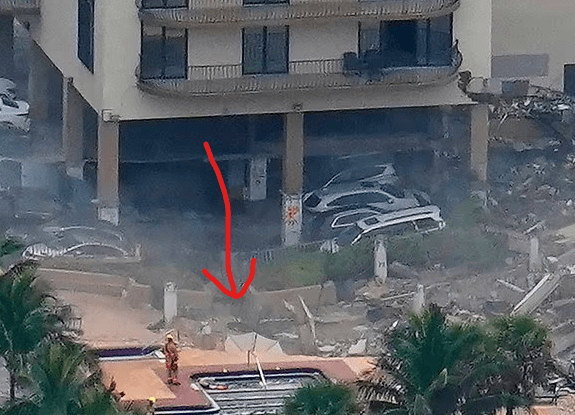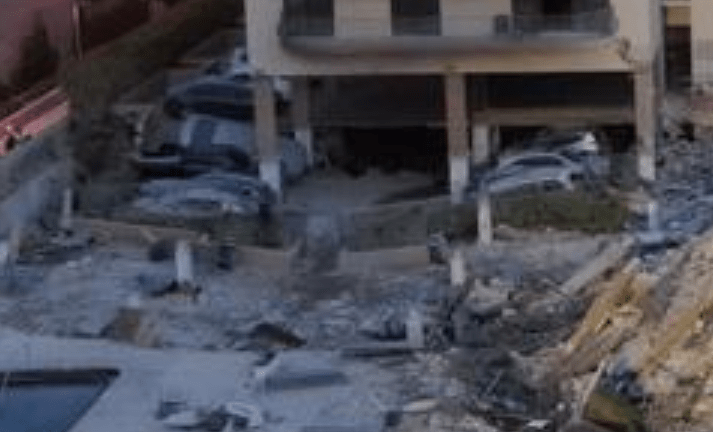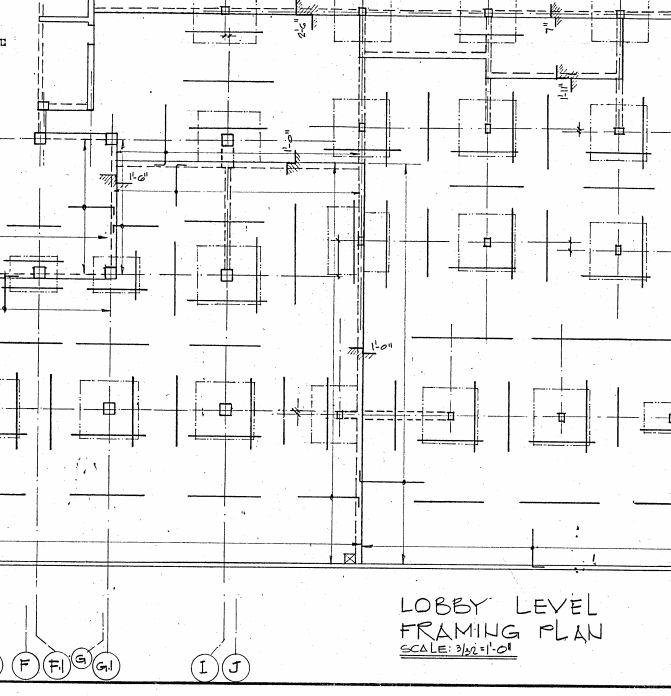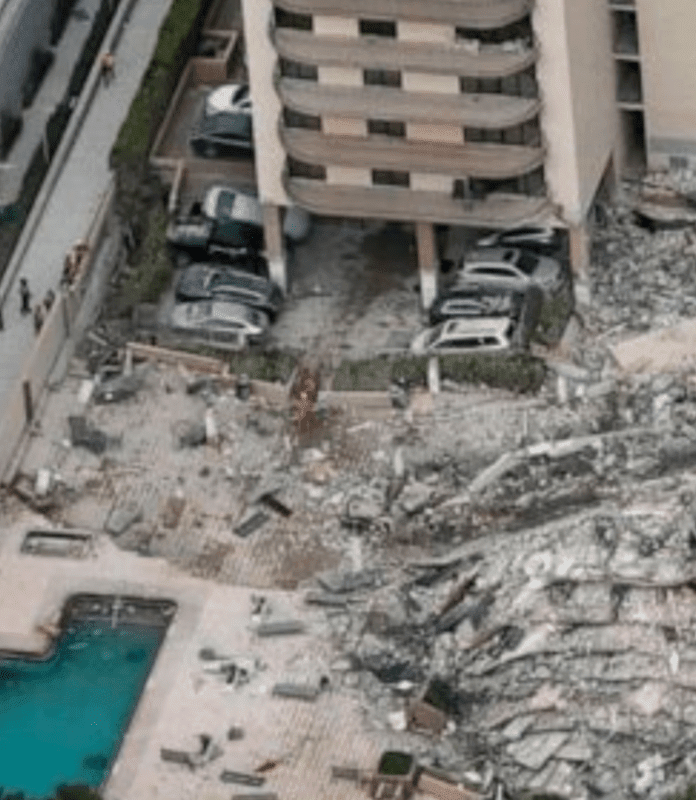Navigation
Install the app
How to install the app on iOS
Follow along with the video below to see how to install our site as a web app on your home screen.
Note: This feature may not be available in some browsers.
More options
Style variation
-
Congratulations MintJulep on being selected by the Eng-Tips community for having the most helpful posts in the forums last week. Way to Go!
You are using an out of date browser. It may not display this or other websites correctly.
You should upgrade or use an alternative browser.
You should upgrade or use an alternative browser.
Miami Beach, Champlain Towers South apartment building collapse, Part 02 151
- Thread starter dik
- Start date
- Status
- Not open for further replies.
As for the fire alarms, some of the video shortly after the collapse showed fire alarm strobes going off throughout the remaining standing building. (for instance, there was one in the penthouse passageway that I noticed). No idea if that started before or after the collapse though.
LittleInch
Petroleum
I keep being struck by the collapse of the above ground parking area.
The slab at that point changes from being attached to the main building columns to the parking garage columns, which are at a wider spacing than the building columns.
ON top of that you have some big heavy planters. This looks like a good place for the initial collapse to start as there is a gap in the planters for access.
Does anyone have an original plan for the top parking area for that surface parking? That's where your bigger heavier vehicles comes into play as well.


Remember - More details = better answers
Also: If you get a response it's polite to respond to it.
The slab at that point changes from being attached to the main building columns to the parking garage columns, which are at a wider spacing than the building columns.
ON top of that you have some big heavy planters. This looks like a good place for the initial collapse to start as there is a gap in the planters for access.
Does anyone have an original plan for the top parking area for that surface parking? That's where your bigger heavier vehicles comes into play as well.


Remember - More details = better answers
Also: If you get a response it's polite to respond to it.
Murph 9000
Computer
LittleInch said:Does anyone have an original plan for the top parking area for that surface parking? That's where your bigger heavier vehicles comes into play as well.
In the big 1979 plans PDF, page 3 shows the spaces on the site plan, or page 15 on the landscaping plan. The basement and lobby/first framing plans give the structural details, I think. It's the same 8 spaces on the collapsed area. Planters are pretty much the same, from a quick glance. The south side is mostly constrained by columns being at 2 car widths, so spacing can't really have changed over the years.
It's certainly something to look at, if the structural design for it was for up to 4000 lb cars, and someone has been driving a 10000 lb construction / service truck on it (for example). It has limited height, but it's still a plausible scenario to look at with the construction activities that were ongoing.
I'm curious if/how the insurance company for the building is going to try to get out of paying..
I imagine since is it is a condo there should be a global policy for all the units and a separate policy that covers the homeowners association's actions.
I can see one suing the other for negligence.
I imagine since is it is a condo there should be a global policy for all the units and a separate policy that covers the homeowners association's actions.
I can see one suing the other for negligence.
relevant video to the landscaping/planter discussion?
NEW: An attorney representing one of the #SurfsideCollapse survivors says she took this video in August of 2018, showing leaks by her car in the building’s underground garage.
Link
NEW: An attorney representing one of the #SurfsideCollapse survivors says she took this video in August of 2018, showing leaks by her car in the building’s underground garage.
Link
Clear version of tiktok video. Rubble can be seen. Another video shows immediate aftermath.
-
1
- #268
LittleInch
Petroleum
OK, those plans make interesting reading.
The bit that I'm looking at is the change in column spacing and size from the columns under the building to the pool area.
The spacing changes from 23 feet in a NS direction to 29 feet and smaller columns. The rest of the patio deck is 19 feet spacing and all you have on top is scattered people, not 2-3 tonnes of motor vehicle.
At the same time the EW spacing changes from 20 ft to 23 feet.
Then critically and only in this location, the pool deck is being used as a car park with added planters located over them.
So below the car park spaces on the ground level are in red and the planters are in green.
So is this enough to make this (the blue bit) the most highly stressed bit of pool deck and hence most likely to fail first?
There i one drawing showing a beam which looks to be in that location but no evidence in the collapse photos.


Remember - More details = better answers
Also: If you get a response it's polite to respond to it.
The bit that I'm looking at is the change in column spacing and size from the columns under the building to the pool area.
The spacing changes from 23 feet in a NS direction to 29 feet and smaller columns. The rest of the patio deck is 19 feet spacing and all you have on top is scattered people, not 2-3 tonnes of motor vehicle.
At the same time the EW spacing changes from 20 ft to 23 feet.
Then critically and only in this location, the pool deck is being used as a car park with added planters located over them.
So below the car park spaces on the ground level are in red and the planters are in green.
So is this enough to make this (the blue bit) the most highly stressed bit of pool deck and hence most likely to fail first?
There i one drawing showing a beam which looks to be in that location but no evidence in the collapse photos.


Remember - More details = better answers
Also: If you get a response it's polite to respond to it.
TheGreenLama
Structural
From reports coming out it sounds like this building in particular had a dysfunctional set of homeowners. A couple of questions for Florida residents:
1) Are there any safeguards (i.e. laws) in place to prevent some condo owners from stonewalling paying for repairs to the common building until after they sell/flip their individual units? If not I can imagine it would be quite a common practice. Simply sell, move to another building, wait until large maintenance assessments are projected, sell and start the process again. There was mention earlier of a recent buyer of a unit in this building who knew nothing of the 2018 report. Did this buyer also know nothing of the impending maintenance assessment, or is this more of a buyer not doing the proper homework?
2) FL has something called Homestead Laws. I'll probably butcher this, but from what I gather these laws shield the property an individual owns and calls home from creditors. Do these laws also apply to condos? If condos do fall into this category, could these laws inadvertently create a culture of impunity w.r.t. individual owners not wanting to contribute to the common good of the building? I really don't know how condo assoc. and condo boards work in this state or any other, so this question could be way off base.
1) Are there any safeguards (i.e. laws) in place to prevent some condo owners from stonewalling paying for repairs to the common building until after they sell/flip their individual units? If not I can imagine it would be quite a common practice. Simply sell, move to another building, wait until large maintenance assessments are projected, sell and start the process again. There was mention earlier of a recent buyer of a unit in this building who knew nothing of the 2018 report. Did this buyer also know nothing of the impending maintenance assessment, or is this more of a buyer not doing the proper homework?
2) FL has something called Homestead Laws. I'll probably butcher this, but from what I gather these laws shield the property an individual owns and calls home from creditors. Do these laws also apply to condos? If condos do fall into this category, could these laws inadvertently create a culture of impunity w.r.t. individual owners not wanting to contribute to the common good of the building? I really don't know how condo assoc. and condo boards work in this state or any other, so this question could be way off base.
@Retiredat46
I don't have a clear comparison on saltwater vs fertilizer corrosion but here are some thoughts... Corrosion is an electrochemical process that needs the presence of an electrolyte for ions to flow and the corrosion process to continue. Unfortunately, saltwater is an excellent electrolyte. Chlorides also will limit the protection to the reinforcing steel provided by the alkaline environment of the concrete.
As for fertilizers, they are possibly introducing chlorides as well. But some fertilizers lower the pH of the soil as do some types of mulch. A more acidic environment that is constantly moist would seemingly be more aggressive for rebar corrosion than just salt spray alone.
I wonder if these planters were lined?
Bradley Wilder, P.E.
Construction P.E. (KY), MBA
Bridge Rehab, Coatings, Structural Repair
I don't have a clear comparison on saltwater vs fertilizer corrosion but here are some thoughts... Corrosion is an electrochemical process that needs the presence of an electrolyte for ions to flow and the corrosion process to continue. Unfortunately, saltwater is an excellent electrolyte. Chlorides also will limit the protection to the reinforcing steel provided by the alkaline environment of the concrete.
As for fertilizers, they are possibly introducing chlorides as well. But some fertilizers lower the pH of the soil as do some types of mulch. A more acidic environment that is constantly moist would seemingly be more aggressive for rebar corrosion than just salt spray alone.
I wonder if these planters were lined?
Bradley Wilder, P.E.
Construction P.E. (KY), MBA
Bridge Rehab, Coatings, Structural Repair
-
1
- #271
Looking at the photos from Littleinch post of 1 Jul 21 08:39 there may be a design shortcoming in the apron ground floor slab.
Outside it is where the swimming pool is located. Nearer to the building it is the parking area just outside the building at the ground floor. The pool side section had almost no load except swimmers using the pool. The parking section has to take the vehicular load.
The majority of this ground floor apron slab seems to have fallen bodily onto the first floor below ground. That may be due to the debris of the collapsed building forcing the whole slab to sink as a consequential effect as the pool section had no reason to deflect on its own with little or no live load.
The alarming feature is the slab failed at almost every column position by punching shear as though there was no structural connection between the columns and the slab. This is certainly the impression I got from the larger columns that are still supporting the building. The pool portion of the slab might have the connection structurally broken off at the top. Thus the slab was relatively strong in design but its connections with the columns appearto be structurally substandard to fail in this manner.
Here is a comparison between before and after the collapse. "Before" is from the current Google Map. The white paint on the columns I believe signifies the lower level.

Outside it is where the swimming pool is located. Nearer to the building it is the parking area just outside the building at the ground floor. The pool side section had almost no load except swimmers using the pool. The parking section has to take the vehicular load.
The majority of this ground floor apron slab seems to have fallen bodily onto the first floor below ground. That may be due to the debris of the collapsed building forcing the whole slab to sink as a consequential effect as the pool section had no reason to deflect on its own with little or no live load.
The alarming feature is the slab failed at almost every column position by punching shear as though there was no structural connection between the columns and the slab. This is certainly the impression I got from the larger columns that are still supporting the building. The pool portion of the slab might have the connection structurally broken off at the top. Thus the slab was relatively strong in design but its connections with the columns appearto be structurally substandard to fail in this manner.
Here is a comparison between before and after the collapse. "Before" is from the current Google Map. The white paint on the columns I believe signifies the lower level.

RickyTickyTavi
Structural
Planters are often lined (here in houston, tx) and fail like every 1-2 decades or so- which then facilitates replacement or removal of the planters. At least in renovation/repair projects Ive been involved in.
-
1
- #273
Can't help but wonder if the future deck slab renovation contractors dodged a bullet here. Would they have realized how precarious a state this structure was in and shored up the structure sufficiently?
Although it seems likely the jolt and bending forces added to the main columns as the slabs collapsed was what precipitated their failure, isn't it possible this entire deck superstructure was providing stability, framing to the critical columns?
Although it seems likely the jolt and bending forces added to the main columns as the slabs collapsed was what precipitated their failure, isn't it possible this entire deck superstructure was providing stability, framing to the critical columns?
LittleInch (Petroleum),
An earlier photo in the Part I of this thread

Shows the pool area slab has partly sunk relatively to the pool which appears to be relatively stable with water still inside. Thus the weight of the pool triggering the collapse will need new evidence able to explain the above photo. Remember the same slab outside the pool has sunk more but it has virtually no live load.
An earlier photo in the Part I of this thread

Shows the pool area slab has partly sunk relatively to the pool which appears to be relatively stable with water still inside. Thus the weight of the pool triggering the collapse will need new evidence able to explain the above photo. Remember the same slab outside the pool has sunk more but it has virtually no live load.
NOLAscience
Structural
RE: Column in Planter and Planters above Reinforced Concrete, in General
Adding to bradw1128's comment about corrosion and fertilizers that lower pH, you can expect that the landscape maintenance company would apply the type of fertilizer that will provide optimum pH for growing palm trees. (The planters had palm trees from at least 2005 to 2018, when the plant scheme underwent a major revision.) I found this, "Palm trees grow best in a moderately acid to slightly alkaline soil ranging between 5.5 to 7.5 on the pH scale. Most average garden soils fall between a pH range of 6.0 to 7.0."
Retiredat46 said:In regards to the columns in or adjacent to the planters, does anyone know how the corrosive nature of fertilizers compares to that of salt water? I know both are bad, but I don't know which is worse.
It seems likely that fertilizers would have been used in the planters to some extent over the years, and it could have accelerated the degradation of the steel and concrete in the columns.
Adding to bradw1128's comment about corrosion and fertilizers that lower pH, you can expect that the landscape maintenance company would apply the type of fertilizer that will provide optimum pH for growing palm trees. (The planters had palm trees from at least 2005 to 2018, when the plant scheme underwent a major revision.) I found this, "Palm trees grow best in a moderately acid to slightly alkaline soil ranging between 5.5 to 7.5 on the pH scale. Most average garden soils fall between a pH range of 6.0 to 7.0."
@TheGreenLama
(Disclaimer: I'm not a lawyer, just relaying related experience)
1) I'm in KY not FL, but a few years ago here several HOA's banded together to buy the golf course in their neighborhood after it went bankrupt. They used a special assessment spread over several years. I'm fuzzy on the details, but in that case, there were questions about if the assessment was legally enforceable on all the homeowners and the answer given was that yes it was.
I read somewhere that this building's maintenance bill was being funded upfront with a line of credit that the HOA has acquired. The homeowners would then pay down the line of credit over time with the assessment. It wasn't a case where everyone was going to write a check for $100k on day one. Surely at some point that becomes a legal obligation to the owner, current or future. Whether that actually gets disclosed to buyers before the assessment is official is a fair concern.
Units in the building were selling in the $500-700k range. IMO, $100k proportional to property value is not out of line for what you might spend on a major renovation of any property this age. For example, for a typical $200k house, a proportional amount is $30-40k which is a lot but not obscene for renovating a 40-year-old house with some deferred maintenance.
2) From what I remember based on a few friends who have homes in Florida, yes condos qualify for the homestead exemption.There are limits to value (edit: wrong, I Googled it) and you have to live there a certain amount of time (~3 years) and use it as your primary residence. Vacation homes and rental properties don't count. How this plays out in HOA politics, I could only guess.
Bradley Wilder, P.E.
Construction P.E. (KY), MBA
Bridge Rehab, Coatings, Structural Repair
(Disclaimer: I'm not a lawyer, just relaying related experience)
1) I'm in KY not FL, but a few years ago here several HOA's banded together to buy the golf course in their neighborhood after it went bankrupt. They used a special assessment spread over several years. I'm fuzzy on the details, but in that case, there were questions about if the assessment was legally enforceable on all the homeowners and the answer given was that yes it was.
I read somewhere that this building's maintenance bill was being funded upfront with a line of credit that the HOA has acquired. The homeowners would then pay down the line of credit over time with the assessment. It wasn't a case where everyone was going to write a check for $100k on day one. Surely at some point that becomes a legal obligation to the owner, current or future. Whether that actually gets disclosed to buyers before the assessment is official is a fair concern.
Units in the building were selling in the $500-700k range. IMO, $100k proportional to property value is not out of line for what you might spend on a major renovation of any property this age. For example, for a typical $200k house, a proportional amount is $30-40k which is a lot but not obscene for renovating a 40-year-old house with some deferred maintenance.
2) From what I remember based on a few friends who have homes in Florida, yes condos qualify for the homestead exemption.
Bradley Wilder, P.E.
Construction P.E. (KY), MBA
Bridge Rehab, Coatings, Structural Repair
saikee119 said:Shows the pool area slab has partly sunk relatively to the pool which appears to be relatively stable with water still inside. Thus the weight of the pool triggering the collapse will need new evidence able to explain the above photo. Remember the same slab outside the pool has sunk more but it has virtually no live load.
The pool is actually supported by 21 piles and has full height exterior concrete walls. It was not adding any weight to the nearby structure, but contrarily, it was providing support to the column-slab connections in close proximity.
-
1
- #280
OSUCivlEng
Civil/Environmental
I wonder how this tragedy will influence engineers and engineering firms who are asked to evaluate buildings for the 40 year recertification process? I also wonder how this will affect the residents of current condos in south Florida? I imagine there are a lot of very worried people right now.
- Status
- Not open for further replies.
Similar threads
- Replies
- 4
- Views
- 22K
- Locked
- Question
- Replies
- 120
- Views
- 15K
- Replies
- 4
- Views
- 758
- Locked
- Question
- Replies
- 1
- Views
- 2K
- Locked
- Question
- Replies
- 4
- Views
- 5K
